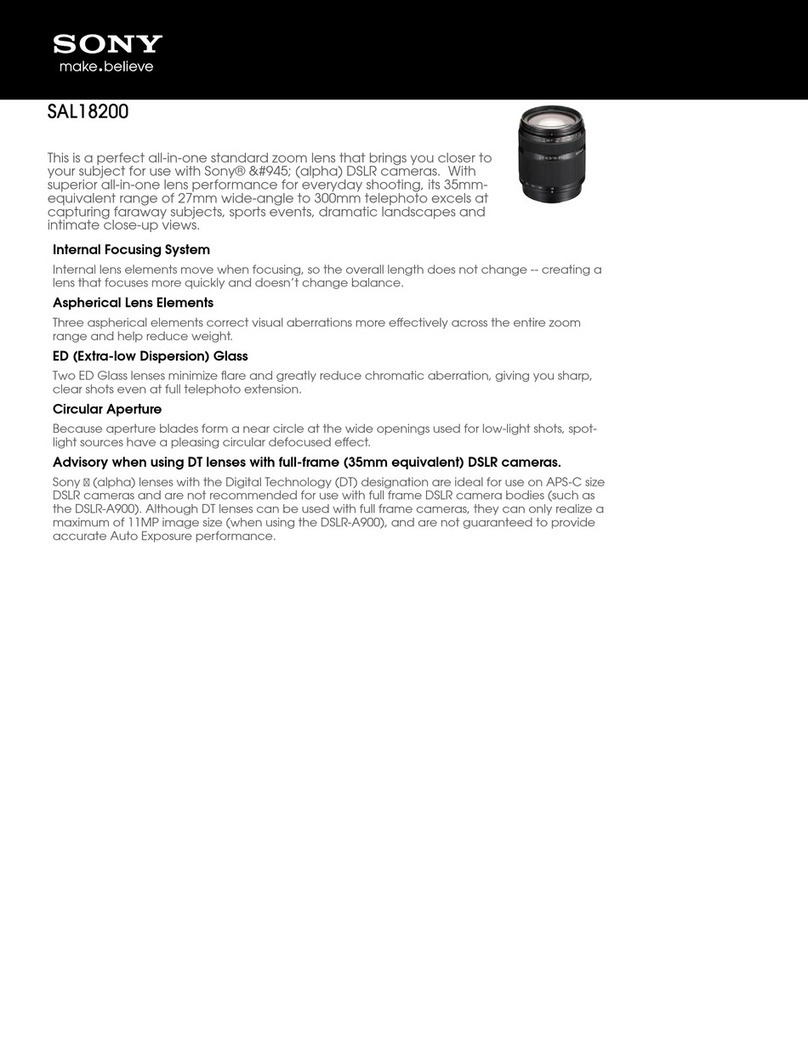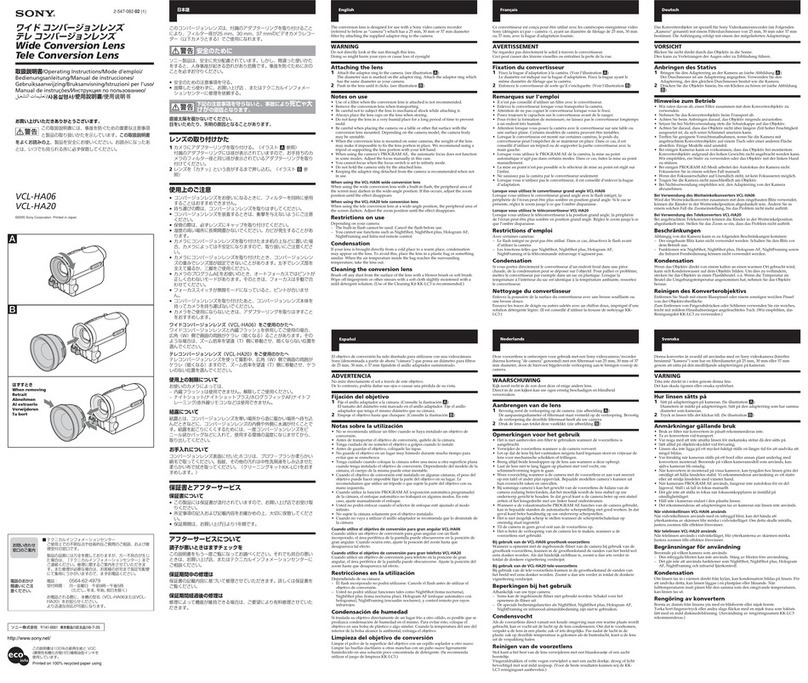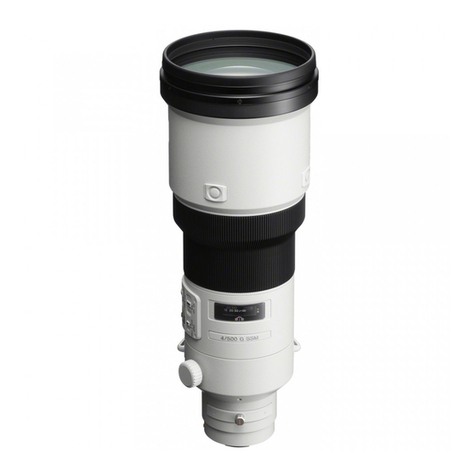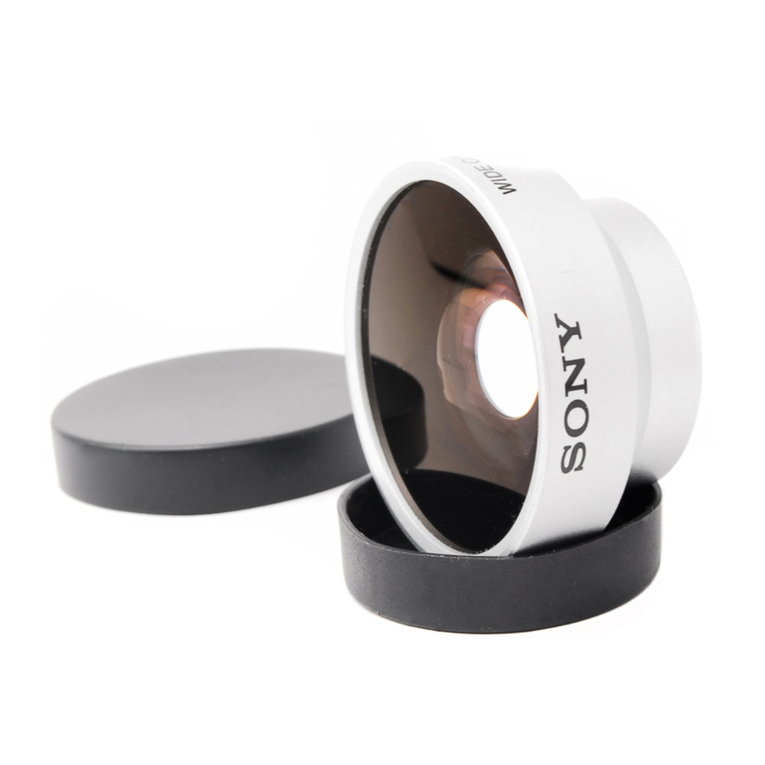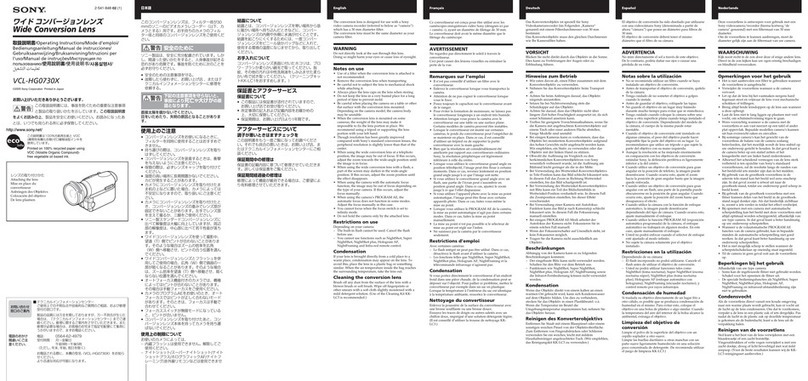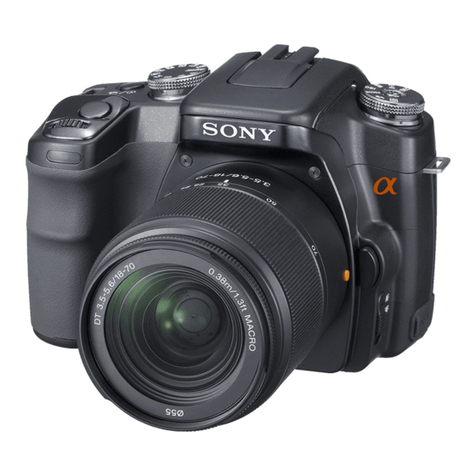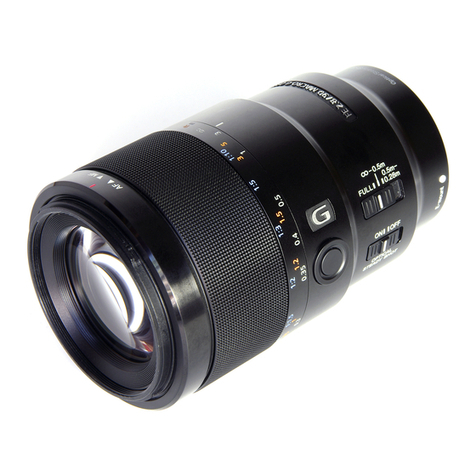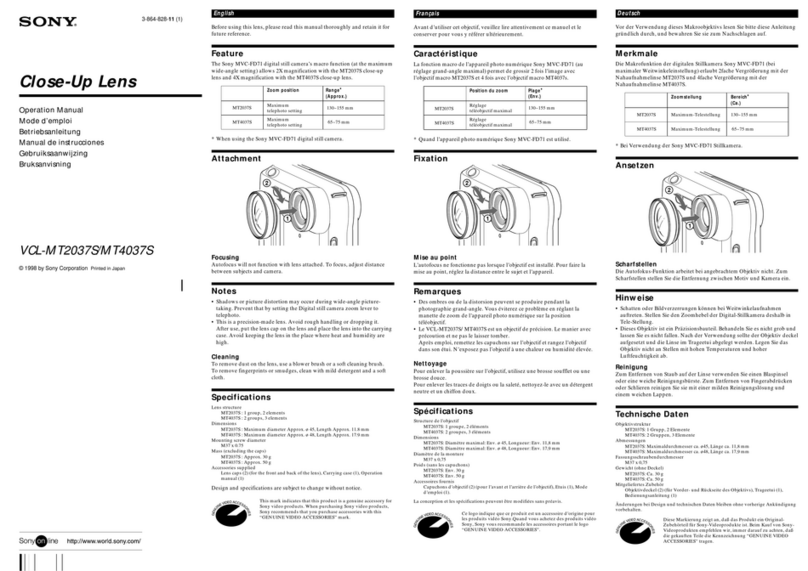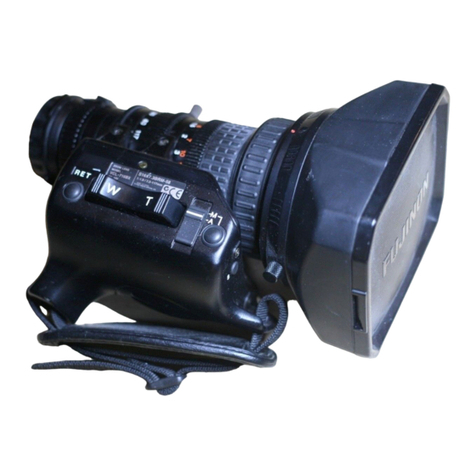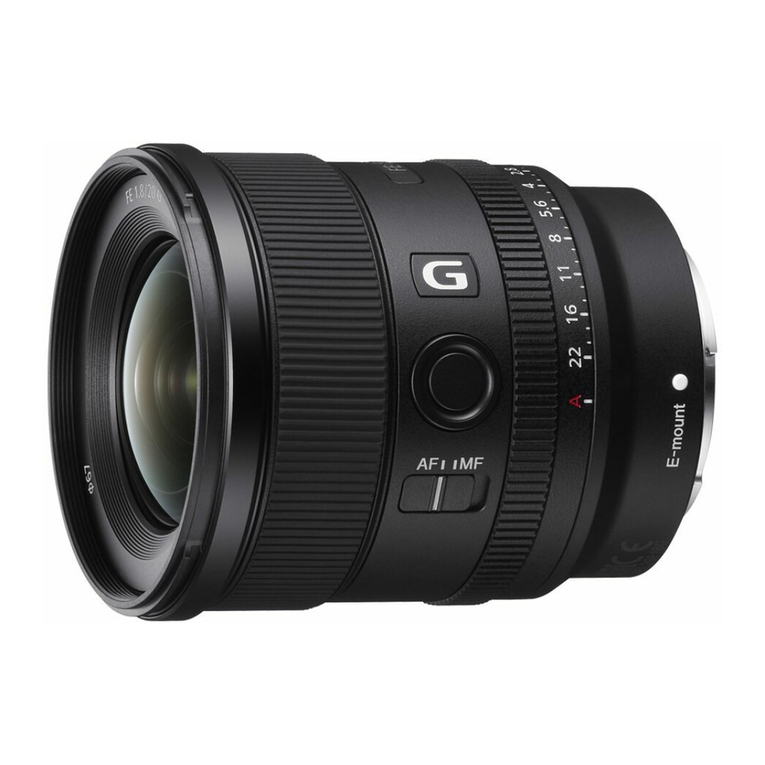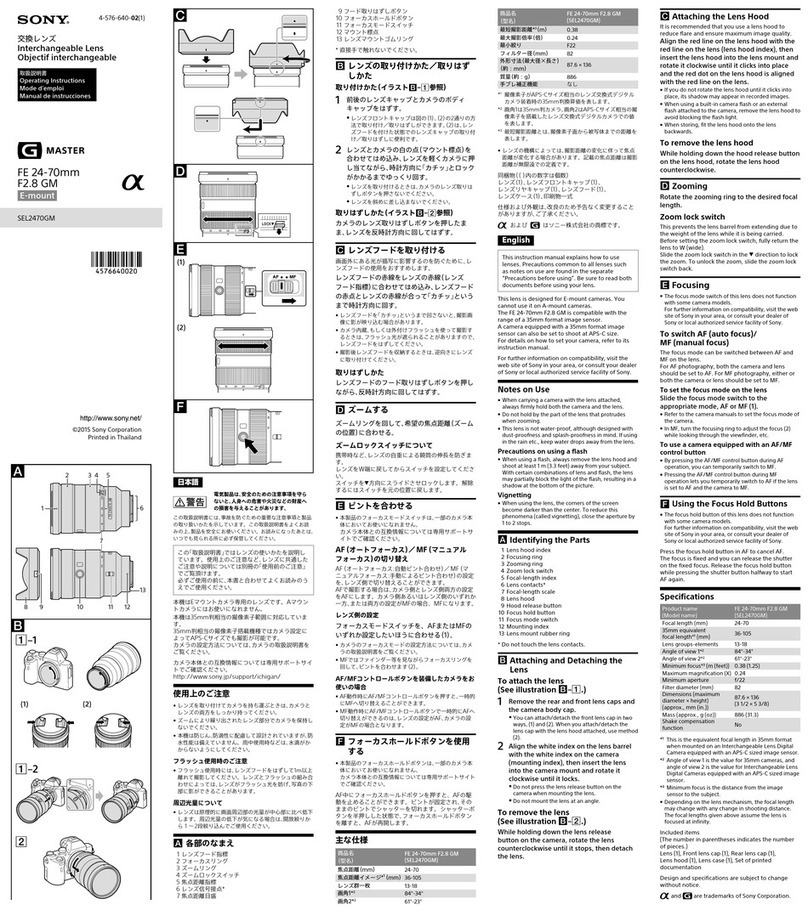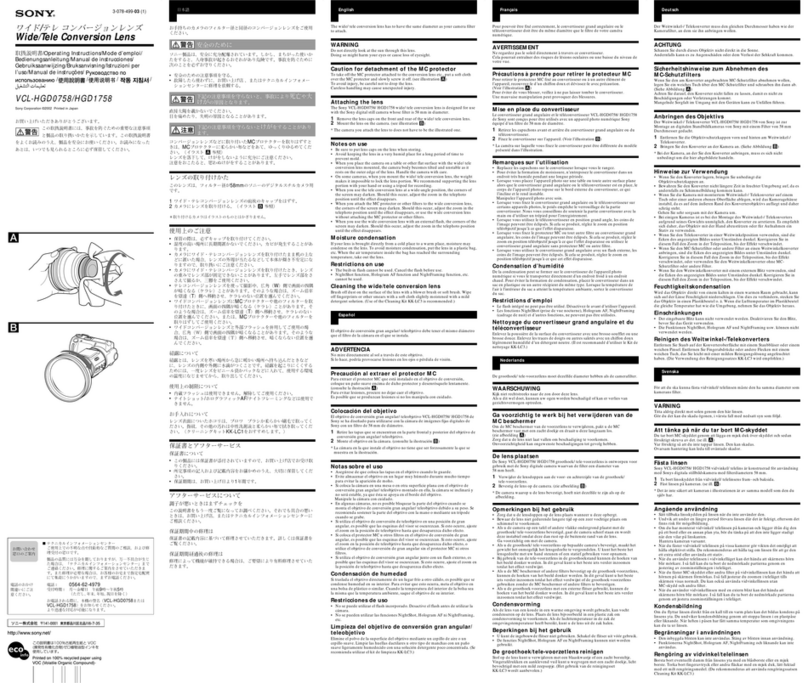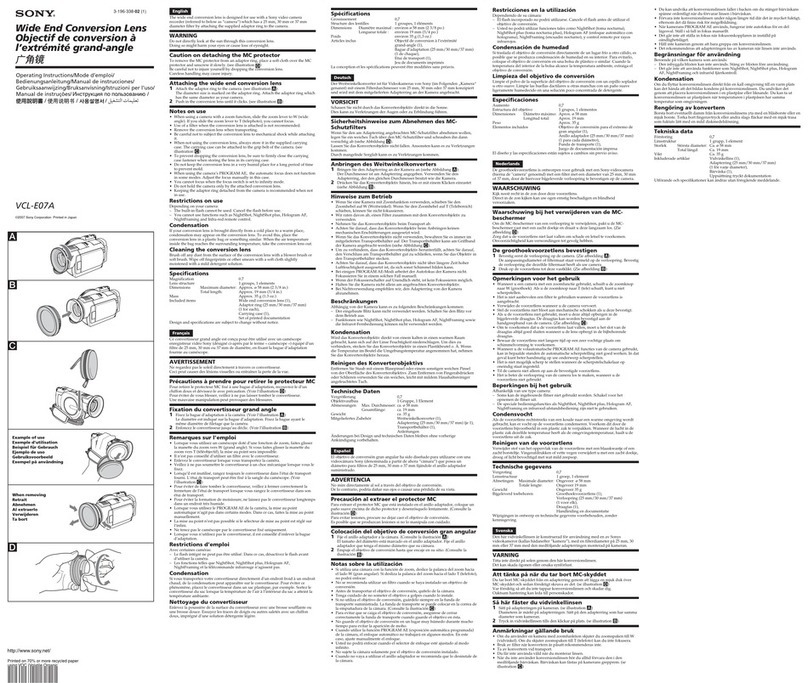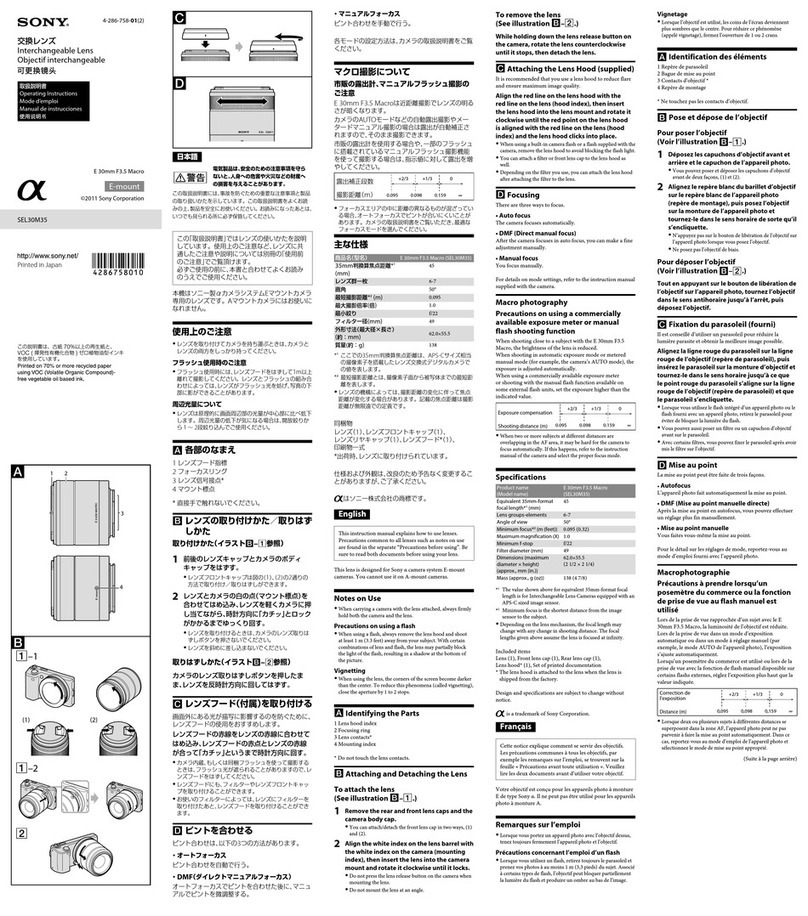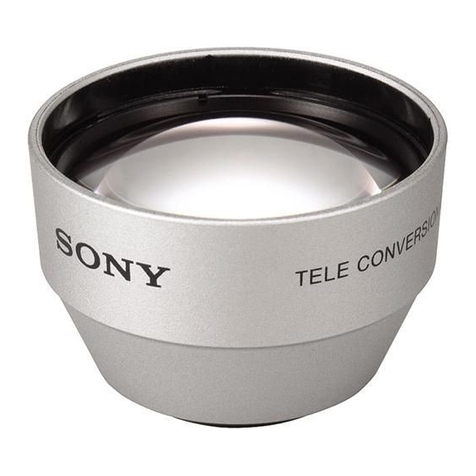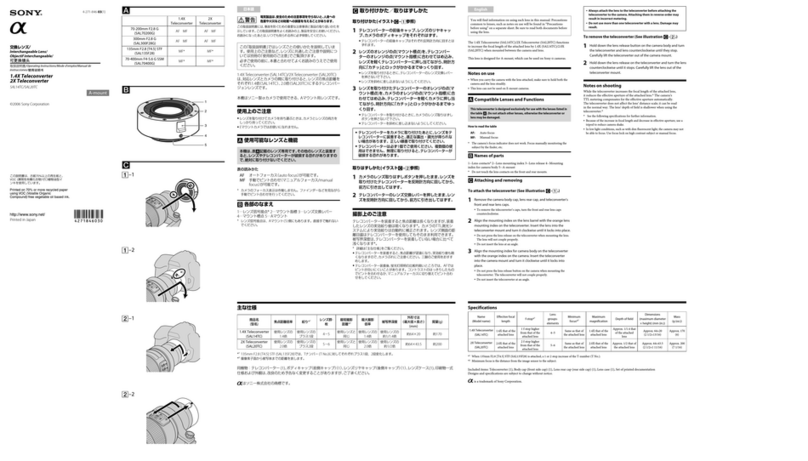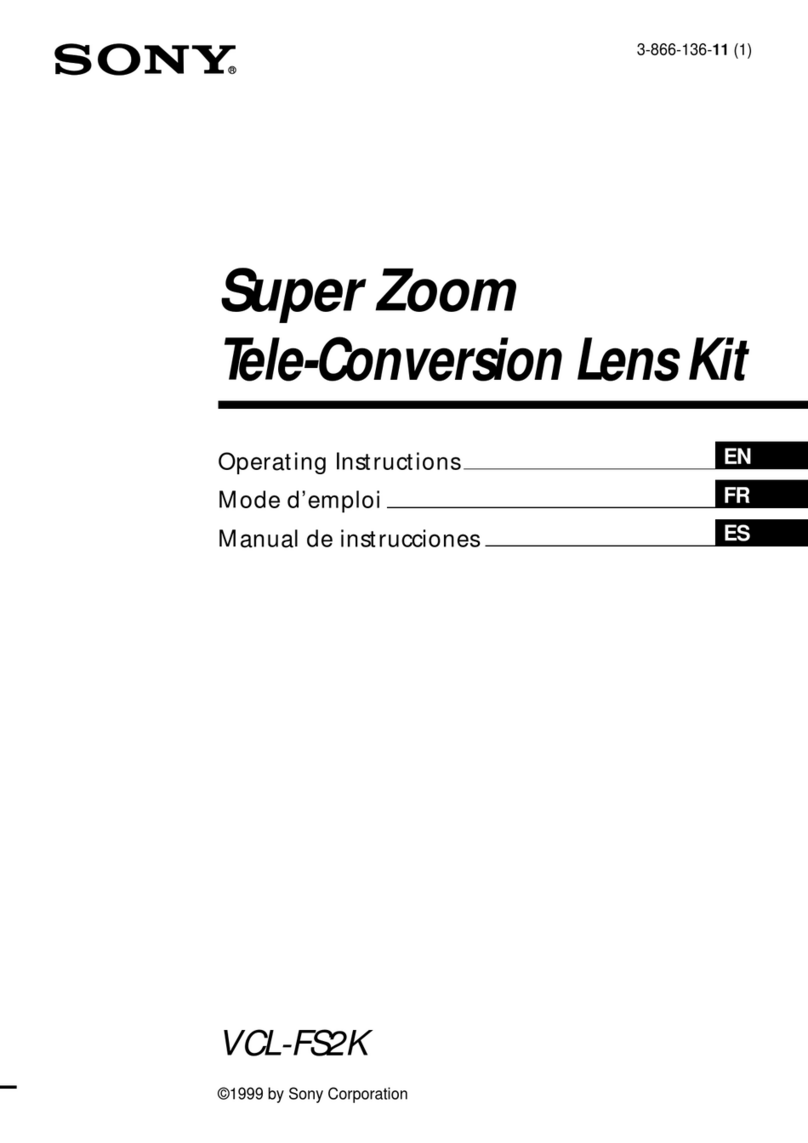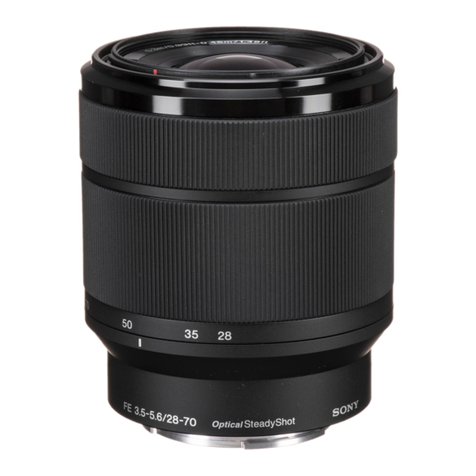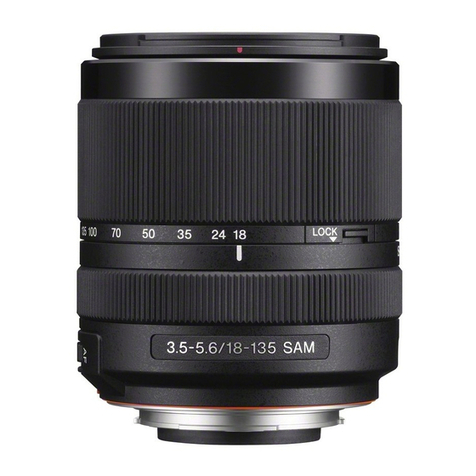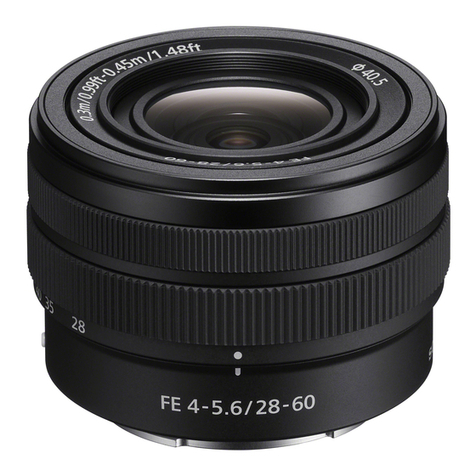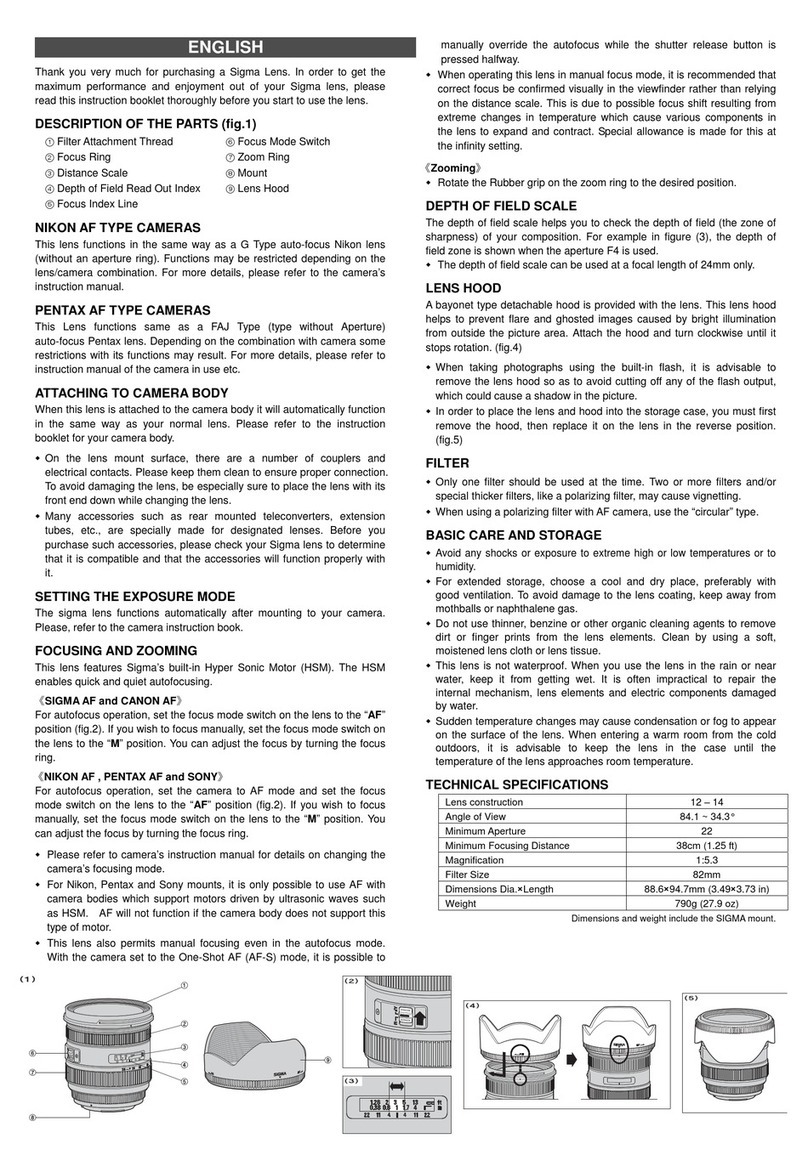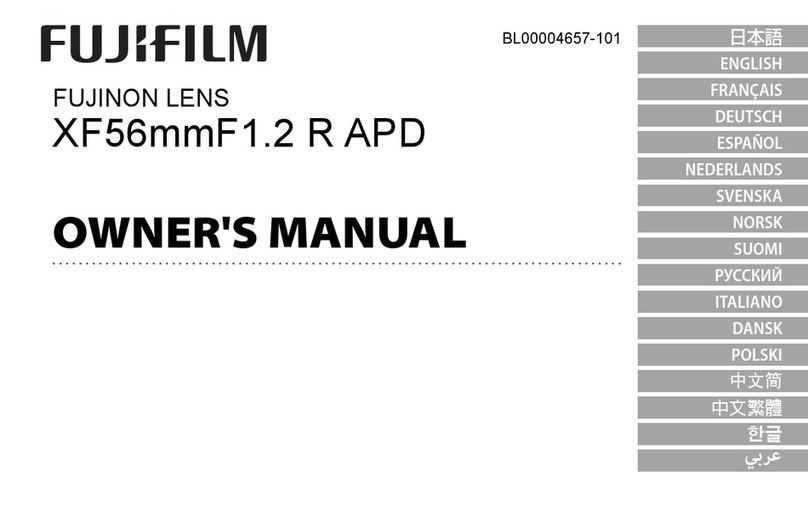
–1
(1) (2)
–2
(1)
(2)
Fixation du pare-soleil
Il est conseillé d'utiliser un pare-soleil pour réduire
la lumière parasite et obtenir la meilleure image
possible.
Alignez la ligne rouge du pare-soleil sur la
ligne rouge de l'objectif (repère de pare-
soleil), puis insérez le pare-soleil sur la
monture d'objectif et tournez-le dans le sens
des aiguilles d'une montre jusqu'à ce qu'il
s'encliquette et le point rouge du pare-soleil
s'aligne sur la ligne rouge de l'objectif.
Lorsque vous utilisez le flash intégré d’un appareil
photo ou un flash externe fixé à l'appareil photo,
retirez le pare-soleil pour éviter de bloquer la lumière
du flash.
Pour ranger le pare-soleil, insérez-le à l'arrière de
l'objectif.
Zoom
Tournez la bague de zoom selon la focale
souhaitée.
Mise au point
Le mode de mise au point de cet objectif ne fonctionne
pas sur certains modèles d’appareils photo.
Pour plus d’informations sur la compatibilité,
consultez le site de Sony de votre pays, ou adressez-
vous à un revendeur Sony ou à un service après-vente
agréé Sony.
Pour commuter entre AF (mise au
point automatique) et MF (mise au
point manuelle)
Il est possible de régler le mode de mise au point
sur AF ou MF sur l’objectif.
Pour la photographie en mode AF, l’appareil photo
et l’objectif doivent être tous les deux réglés sur AF.
Pour la photographie en mode MF, l’appareil photo
ou l’objectif, ou bien les deux, doivent être réglés
sur MF.
Pour régler le mode de mise au point sur
l’objectif
Réglez le commutateur de mode de mise au
point sur le mode adapté, AF ou MF (1).
Reportez-vous aux manuels de l’appareil photo pour
régler le mode de mise au point sur l’appareil photo.
En mode MF, tournez la bague de mise au point pour
faire la mise au point (2) tout en regardant dans le
viseur, etc.
Pour utiliser un appareil photo pourvu
d’une touche de commande AF/MF
En appuyant sur la touche de commande AF/MF en
mode AF, vous pouvez provisoirement passer en
mode MF.
En appuyant sur la touche de commande AF/MF
en mode MF, vous pouvez provisoirement passer
en mode AF si l’appareil photo est réglé sur MF et
l’objectif sur AF.
Utilisation des boutons de
maintien de la mise au point
Le bouton de maintien de la mise au point de cet
objectif ne fonctionne pas sur certains modèles
d’appareils photo.
Pour plus d’informations sur la compatibilité,
consultez le site de Sony de votre pays, ou adressez-
vous à un revendeur Sony ou à un service après-vente
agréé Sony.
Appuyez sur le bouton de maintien de la mise au
point en mode AF pour annuler AF. La mise au point
est fixée et vous pouvez déclencher avec cette mise
au point. Appuyez sur le bouton de maintien de la
mise au point tout en appuyant sur le déclencheur
à mi-course pour recommencer la mise au point
automatique.
Utilisation de la fonction
antibougé
Commutateur antibougé
ON : compense les tremblements de l’appareil photo.
OFF : ne compense pas les tremblements de
l’appareil photo. Nous conseillons de régler le
commutateur antibougé sur OFF lors de la prise
de vue sur un trépied.
Spécifications
Nom de produit
(Nom de modèle)
FE 24-105mm F4 G OSS
(SEL24105G)
Longueur focale (mm) 24-105
Longueur focale équivalente à
35 mm*1(mm) 36-157,5
Éléments-groupes de lentilles 14-17
Angle de champ 1*284°-23°
Angle de champ 2*261°-15°
Mise au point minimale*3
(m (pieds)) 0,38 (1,25)
Grossissement maximal (X) 0,31
Ouverture minimale f/22
Diamètre d’objectif (mm) 77
Dimensions (diamètre
maximal × hauteur)
(environ, mm (po.))
83,4 × 113,3
(3 3/8 × 4 1/2)
Nom de produit
(Nom de modèle)
FE 24-105mm F4 G OSS
(SEL24105G)
Poids (environ, g (oz)) 663 (23,4)
Fonction Antibougé Oui
*1Longueur focale équivalente en format 35 mm
lorsque installé sur un appareil photo à objectif
interchangeable avec capteur d’image de taille
APS-C.
*2L’angle de champ 1 est la valeur correspondant aux
appareils photo 35 mm et l’angle de champ 2 est la
valeur corrspondant aux appareils photo à objectif
interchangeable équipés d’un capteur d’image
APS-C.
*3La mise au point minimale est la distance du capteur
d’image au sujet. La mise au point minimale est de
0,41 m (1,35 pieds) à une plage de zoom moyenne
(environ 70 mm).
Selon le mécanisme de l’objectif, la focale peut
changer lorsque la distance de prise de vue change.
Les focales indiquées ci-dessus présupposent que
l’objectif est réglé sur l’infini.
Articles inclus
(Le chiffre entre parenthèses indique le nombre
d’unités.)
Objectif (1), Capuchon d’objectif avant (1),
Capuchon d’objectif arrière (1), Pare-soleil (1),
Boîtier d’objectif (1), Jeu de documents imprimés
La conception et les spécifications peuvent être
modifiées sans préavis.
et sont des marques commerciales de Sony
Corporation.
En este manual se explica cómo utilizar
objetivos. Las precauciones comunes a todos
los objetivos, como notas sobre la utilización,
se encuentran en las “Precauciones previas a
la utilización del producto” suministradas por
separado. Cerciórese de leer ambos documentos
antes de utilizar su objetivo.
Este objetivo está diseñado para cámaras con
montura E. No podrá utilizarse con cámaras con
montura A.
El FE 24-105mm F4 G OSS es compatible con la
gama de un sensor de imágenes de formato de
35 mm Una cámara equipada con un sensor de
imágenes de formato de 35 mm puede establecerse
para fotografiar con tamaño APS-C.
Con respecto a los detalles sobre cómo configurar
su cámara, consulte su manual de instrucciones.
Para más información sobre compatibilidad, visite
el sitio Web de Sony de su área, o consulte a su
proveedor Sony o a un centro de servicio local
autorizado por Sony.
Notas sobre la utilización
No deje el objetivo expuesto al sol o a fuentes de
luz intensas. Es posible que se produzcan fallos de
funcionamiento interno del cuerpo de la cámara y del
objetivo, humo, o un incendio como efecto de la luz
directa. Si las circunstancias exigen dejar el objetivo
expuesto a la luz solar, asegúrese de colocar las tapas
del objetivo.
Cuando fotografíe contra el sol, mantenga el sol
completamente fuera del ángulo de visión. De lo
contrario, los rayos solares podrían concentrarse en
un punto en el interior de la cámara, causando humo
o un incendio. Mantener el sol ligeramente fuera del
ángulo de visión también puede causar humo o un
incendio.
Cuando transporte una cámara con el objetivo fijado,
sujete siempre firmemente tanto la cámara como el
objetivo.
No sujete por la parte del objetivo que sobresale
cuando se utiliza el zoom.
Este objetivo no es impermeable, aunque se ha
diseñado teniendo en cuenta la resistencia al polvo
y a las salpicaduras. Si se utiliza bajo la lluvia, etc.,
mantenga las gotas de agua alejadas del objetivo.
Precauciones sobre la utilización de un
flash
Este objetivo no podrá utilizarse con un flash
incorporado en la cámara. Utilice un flash externo
(vendido aparte).
Cuando utilice un flash, el objetivo puede bloquear
parcialmente la luz del flash, lo que resultará en una
sombra en la parte inferior de la fotografía.
Viñeteado
Si utiliza el objetivo, las esquinas de la pantalla se
vuelven más oscuras que el centro. Para reducir este
fenómeno (llamado viñeteado), cierre la apertura de
1 a 2 puntos.
Identificación de las partes
1 Índice del parasol de objetivo
2 Anillo de enfoque
3 Anillo de zoom
4 Índice de distancia focal
5 Contactos del objetivo*
6 Escala de distancia focal
7 Parasol de objetivo
8 Botón mantener-enfoque
9 Interruptor del modo de enfoque
10 Interruptor de compensación de sacudidas
11 Índice de montaje
12 Anillo de caucho de montaje del objetivo
* No toque los contactos del objetivo.
Colocación y extracción del
objetivo
Para colocar el objetivo
(Consulte la ilustración –.)
1Extraiga las tapas posterior y frontal
del objetivo y la tapa del cuerpo de la
cámara.
Usted podrá colocar/extraer la tapa delantera de
objetivo de dos formas, (1) y (2). Cuando coloque/
extraiga la tapa del objetivo con el parasol de
objetivo fijado, utilice el método (2).
2Alinee el índice blanco del barril del
objetivo con el índice blanco de la
cámara (índice de montaje), y después
inserte el objetivo en la montura de la
cámara y gírelo hacia la derecha hasta
que se bloquee.
No presione el botón de liberación del objetivo de
la cámara cuando monte el objetivo.
No monte el objetivo de forma inclinada.
Para extraer el objetivo
(Consulte la ilustración –.)
Manteniendo presionado el botón de
liberación del objetivo de la cámara, gire
el objetivo hacia la izquierda hasta que se
pare, y después extraiga el objetivo.
Colocación del parasol de
objetivo
Es recomendable utilizar un parasol de objetivo para
reducir los reflejos y garantizar la máxima calidad
de la imagen.
Alinee la línea roja del parasol de objetivo
con la línea roja del objetivo (índice del
parasol de objetivo), después inserte el
parasol de objetivo en la montura del
objetivo, y gírelo hacia la derecha hasta que
chasquee en su lugar y el punto rojo del
parasol de objetivo quede alineado con la
línea roja del objetivo.
Cuando utilice un flash incorporado en la cámara o
un flash externo instalado en la cámara, extraiga el
parasol de objetivo para evitar que se bloquee la luz
del flash.
Cuando guarde la cámara, fije el parasol de objetivo
hacia atrás.
Utilización del zoom
Gire el anillo de zoom hasta la distancia focal
que desee.
Enfoque
El interruptor de modo de enfoque de este objetivo
no funcionará con ciertos modelos de cámaras.
Para más información sobre compatibilidad, visite
el sitio Web de Sony de su área, o consulte a su
proveedor Sony o a un centro de servicio local
autorizado por Sony.
Para cambiar AF (enfoque
automático)/MF (enfoque manual)
El enfoque puede cambiarse entre AF y MF en el
objetivo.
Para fotografiar con AF, tanto la cámara como el
objetivo deberán ajustarse a AF. Para fotografiar
con MF, tanto la cámara como el objetivo deberán
ajustarse a MF.
Para ajustar el modo de enfoque en el
objetivo
Deslice el interruptor del modo de enfoque
hasta el modo apropiado, AF o MF (1).
Para ajustar el modo de enfoque de la cámara,
consulte los manuales de la cámara.
En MF, gire el anillo de enfoque mientras observe a
través del visor, etc., para ajustar el enfoque (2).
Para utilizar una cámara equipada con
botón de control AF/MF
Pulsando el botón de control AF/MF durante la
operación con AF, podrá cambiar temporalmente a
MF.
Pulsando el botón de control AF/MF durante la
operación con MF, podrá cambiar temporalmente a
AF si el objetivo está ajustado a AF y la cámara a MF.
Utilización de los botones
mantener-enfoque
El botón mantener-enfoque de este objetivo no
funcionará con ciertos modelos de cámaras.
Para más información sobre compatibilidad, visite
el sitio Web de Sony de su área, o consulte a su
proveedor Sony o a un centro de servicio local
autorizado por Sony.
Pulse el botón mantener-enfoque en AF para
cancelar AF. El enfoque se fijará y podrá accionar
el obturador en el enfoque fijo. Suelte el botón
mantener-enfoque mientras pulse hasta la mitad el
botón del obturador para iniciar de nuevo AF.
Utilización de la función de
compensación de sacudidas
Interruptor de compensación de sacudidas
ON: Compensa las sacudidas de la cámara
OFF: No compensa las sacudidas de la cámara.
Recomendamos poner el interruptor de
compensación de sacudidas en OFF cuando
realice tomas con un trípode.
Especificaciones
Nombre del producto
(Nombre del modelo)
FE 24-105mm F4 G OSS
(SEL24105G)
Distancia focal (mm) 24-105
Distancia focal equivalente
a 35 mm*1(mm) 36-157,5
Grupos y elementos del
objetivo 14-17
Ángulo de visión 1*284°-23°
Ángulo de visión 2*261°-15°
Enfoque mínimo*3(m) 0,38
Ampliación máxima (X) 0,31
Apertura mínima f/22
Diámetro del filtro (mm) 77
Dimensiones (diámetro
máximo × altura)
(Aprox., mm)
83,4 × 113,3
Peso (Aprox., g) 663
Función de compensación
de sacudidas
Sí
*1Esta es la distancia focal equivalente al formato de
35mm cuando se monta en una cámara digital de
lentes intercambiables equipada con un sensor de
imágenes de tamaño APS-C.
*2El ángulo de visión 1 es el valor para cámaras de
formato de 35 mm y el ángulo de visión 2 es el valor
para cámaras digitales de lentes intercambiables
equipadas con un sensor de imágenes de tamaño
APS-C.
*3El enfoque mínimo es la distancia desde el sensor de
imágenes al motivo. El enfoque mínimo es de 0,41 m
en un rango de zoom medio (alrededor de 70 mm).
En función del mecanismo del objetivo, es posible
que la distancia focal varíe si la distancia de toma
de imagen también lo hace. Las distancias focales
indicadas arriba asumen que el objetivo está
enfocado al infinito.
Elementos incluidos
(El número entre paréntesis indica el número de
piezas.)
Objetivo (1), Tapa delantera de objetivo (1),
Tapa trasera de objetivo (1), Parasol de objetivo (1),
Funda del objetivo (1), Juego de documentación
impresa
El diseño y las especificaciones están sujetos a
cambios sin previo aviso.
y son marcas comerciales de Sony
Corporation.
保留备用
本说明书介绍镜头的用法。有关所有镜头
的一般注意事项(如使用须知)可以在另
外的“使用前注意事项”中找到。务必在
使用镜头前阅读以上两份文件。
本镜头是专为 E 卡口系统相机而设计的。 不
能将其用于 A 卡口系统相机。
FE 24-105mm F4 G OSS 与 35mm 规格的
图像传感器系列兼容。
配备 35mm 规格图像传感器的相机可设定为
以 APS-C 尺寸进行拍摄。
有关如何设定相机的详情,请参阅相机的使用
说明书。
有关兼容性的详细信息,请访问所在地区的
Sony 网站,或者咨询您的 Sony 经销商或当
地的 Sony 授权服务机构。
使用须知
请勿将镜头置于阳光或强光下,由于光线聚集
的结果可能会导致相机机身和镜头的内部故
障,或引起冒烟或者火灾。如果在必须将镜头
置于阳光的情况下,请务必盖上镜头盖。
对着阳光方向拍摄时,不要让太阳进入视
角中。否则,阳光可能会在相机的焦点上聚
集,从而引起冒烟或者火灾。即便是在让太
阳略微偏出视角的情况下,仍可能会引起冒
烟或者火灾。
当在装有镜头的情况下携带相机时,请务必
同时握紧相机和镜头。
请勿握住变焦时镜头突出的任何部分。
尽管本镜头采用了防尘和防溅水设计,但不
具备防水性能。在雨中等环境下使用时,应
确保镜头远离水滴。
闪光灯使用注意事项
本镜头不能与内置相机闪光灯一起使用。请
使用外部闪光灯(另售)。
使用闪光灯时,镜头可能会遮住闪光灯的部
分亮光,从而造成图片的底部出现阴影。
晕影
使用镜头时,屏幕的角落要比其中心暗。为
避免这种现象(周边暗角),请将光圈缩小
1 ~ 2 级。
部件识别
1 镜头遮光罩标记
2 对焦环
3 可变焦距圈
4 焦距标记
5 镜头接点*
6 焦距刻度
7 镜头遮光罩
8 对焦锁定按钮
9 对焦模式开关
10 震动补偿开关
11 安装标记
12 镜头安装橡胶环
*请勿触摸镜头接点。
安装/拆下镜头
安装镜头(参见插图 –。)
1 拆下前、后镜头盖和相机机身罩。
可以用 (1) 和 (2) 两种方式安装/拆下前
镜头盖。在不取下镜头遮光罩的情况下
安装/拆下镜头盖时,请使用方法 (2)。
2 将镜筒上的白色标记与相机上的白色
标记(安装标记)对准,然后将镜头
插入相机安装部位并顺时针旋转,直
至镜头锁紧。
请勿在安装镜头时按相机上的镜头释放
按钮。
请勿倾斜安装镜头。
拆下镜头 (参见插图 –。)
按住相机上的镜头释放按钮,逆时针转动
镜头直至其停止,然后拆下镜头。
安装镜头遮光罩
建议使用镜头遮光罩以减少反光,从而确保最
佳画质。
将镜头遮光罩上的红线与镜头上的红线
(镜头遮光罩标记)对准,然后将镜头遮
光罩插入镜头安装部位并顺时针旋转,直
至其咔哒一声就位,且镜头遮光罩上的红
点与镜头上的红线对准。
使用内置相机闪光灯或使用相机上安装的外
部闪光灯时,请取下镜头遮光罩,以免遮住
闪光灯的亮光。
存放时,请将镜头遮光罩倒过来放在镜头
上。
变焦
将可变焦距圈转至所需焦距。
对焦
对于某些型号的相机而言,本镜头的对焦模
式开关无效。
有关兼容性的详细信息,请访问所在地区的
Sony 网站,或者咨询您的 Sony 经销商或当
地的 Sony 授权服务机构。
切换 AF(自动对焦)/MF(手动对焦)
在镜头上,可以在 AF 和 MF 之间切换对焦
模式。
进行 AF 拍摄时,相机和镜头均应设定为
AF。 进行 MF 拍摄时,相机或镜头之一或者
相机和镜头两者应设定为 MF。
在镜头上设定对焦模式
将对焦模式开关滑到相应模式:AF 或
MF (1)。
有关相机的对焦模式设定,请参阅相机的说
明书。
在 MF 模式下,在通过取景器等观察的同
时,转动对焦环调整对焦 (2)。
使用具有 AF/MF 控制按钮的相机
在 AF 操作过程中按 AF/MF 控制按钮,可
临时切换为 MF。
如果镜头设定为 AF 而相机设定为 MF,则
在 MF 操作过程中按 AF/MF 控制按钮可临
时切换为 AF。
使用对焦锁定按钮
对于某些型号的相机而言,本镜头的对焦锁
定按钮无效。
有关兼容性的详细信息,请访问所在地区的
Sony 网站,或者咨询您的 Sony 经销商或当
地的 Sony 授权服务机构。
在 AF 模式下按对焦锁定按钮可取消 AF。 此
时将锁定对焦,而您可以在对焦锁定状态下释
放快门。 在半按快门按钮的同时释放对焦锁
定按钮将重新启动 AF。
使用震动补偿功能
震动补偿开关
ON: 补偿相机震动。
OFF: 不补偿相机震动。使用三脚架拍摄
时,建议将震动补偿开关设为 OFF。
规格
产品名称
(型号名称)
FE 24-105mm F4 G OSS
(SEL24105G)
焦距 (mm) 24-105
相当于 35mm
规格焦距*1 (mm) 36-157.5
镜头组-片 14-17
视角 1*284°-23°
视角 2*261°-15°
最小对焦*3 (m) 0.38
最大放大倍数
(倍) 0.31
最小光圈 f/22
滤光镜直径 (mm) 77
尺寸
(最大直径×长)
(约 mm)
83.4 × 113.3
质量(约 g) 663
震动补偿功能 有
*1 此为当镜头安装在配备 APS-C 尺寸图像传
感器的可更换镜头数码相机上时,相当于
35mm 规格的焦距。
*2 视角 1 的值针对 35mm 相机,而视角 2 的
值针对配备 APS-C 尺寸图像传感器的可更
换镜头数码相机。
*3 最小对焦是从图像传感器至物体的距离。最
小对焦为 0.41 m,对应于变焦范围(约 70
mm)的中间位置。
视镜头结构而异,焦距可能会随拍摄距离的
改变而变化。假设镜头对焦在无限远处。
所含物品
(括号中的数字代表件数。)
镜头 (1)、镜头盖 (1)、镜头后盖 (1)、
镜头遮光罩 (1)、镜头袋 (1)、成套印刷文件
设计或规格如有变动,恕不另行通知。
和 是 Sony Corporation 的商标。
保留备用
本说明书介绍镜头的用法。有关所有镜头
的一般注意事项(如使用须知)可以在另
外的“使用前注意事项”中找到。务必在
使用镜头前阅读以上两份文件。
本镜头是专为 E 卡口系统相机而设计的。 不
能将其用于 A 卡口系统相机。
FE 24-105mm F4 G OSS 与 35mm 规格的
图像传感器系列兼容。
配备 35mm 规格图像传感器的相机可设定为
以 APS-C 尺寸进行拍摄。
有关如何设定相机的详情,请参阅相机的使用
说明书。
有关兼容性的详细信息,请访问所在地区的
Sony 网站,或者咨询您的 Sony 经销商或当
地的 Sony 授权服务机构。
使用须知
请勿将镜头置于阳光或强光下,由于光线聚集
的结果可能会导致相机机身和镜头的内部故
障,或引起冒烟或者火灾。如果在必须将镜头
置于阳光的情况下,请务必盖上镜头盖。
对着阳光方向拍摄时,不要让太阳进入视
角中。否则,阳光可能会在相机的焦点上聚
集,从而引起冒烟或者火灾。即便是在让太
阳略微偏出视角的情况下,仍可能会引起冒
烟或者火灾。
当在装有镜头的情况下携带相机时,请务必
同时握紧相机和镜头。
请勿握住变焦时镜头突出的任何部分。
尽管本镜头采用了防尘和防溅水设计,但不
具备防水性能。在雨中等环境下使用时,应
确保镜头远离水滴。
闪光灯使用注意事项
本镜头不能与内置相机闪光灯一起使用。请
使用外部闪光灯(另售)。
使用闪光灯时,镜头可能会遮住闪光灯的部
分亮光,从而造成图片的底部出现阴影。
晕影
使用镜头时,屏幕的角落要比其中心暗。为
避免这种现象(周边暗角),请将光圈缩小
1 ~ 2 级。
部件识别
1 镜头遮光罩标记
2 对焦环
3 可变焦距圈
4 焦距标记
5 镜头接点*
6 焦距刻度
7 镜头遮光罩
8 对焦锁定按钮
9 对焦模式开关
10 震动补偿开关
11 安装标记
12 镜头安装橡胶环
*请勿触摸镜头接点。
安装/拆下镜头
安装镜头(参见插图 –。)
1 拆下前、后镜头盖和相机机身罩。
可以用 (1) 和 (2) 两种方式安装/拆下前
镜头盖。在不取下镜头遮光罩的情况下
安装/拆下镜头盖时,请使用方法 (2)。
2 将镜筒上的白色标记与相机上的白色
标记(安装标记)对准,然后将镜头
插入相机安装部位并顺时针旋转,直
至镜头锁紧。
请勿在安装镜头时按相机上的镜头释放
按钮。
请勿倾斜安装镜头。
拆下镜头 (参见插图 –。)
按住相机上的镜头释放按钮,逆时针转动
镜头直至其停止,然后拆下镜头。
安装镜头遮光罩
建议使用镜头遮光罩以减少反光,从而确保最
佳画质。
将镜头遮光罩上的红线与镜头上的红线
(镜头遮光罩标记)对准,然后将镜头遮
光罩插入镜头安装部位并顺时针旋转,直
至其咔哒一声就位,且镜头遮光罩上的红
点与镜头上的红线对准。
使用内置相机闪光灯或使用相机上安装的外
部闪光灯时,请取下镜头遮光罩,以免遮住
闪光灯的亮光。
存放时,请将镜头遮光罩倒过来放在镜头
上。
变焦
将可变焦距圈转至所需焦距。
对焦
对于某些型号的相机而言,本镜头的对焦模
式开关无效。
有关兼容性的详细信息,请访问所在地区的
Sony 网站,或者咨询您的 Sony 经销商或当
地的 Sony 授权服务机构。
切换 AF(自动对焦)/MF(手动对焦)
在镜头上,可以在 AF 和 MF 之间切换对焦
模式。
进行 AF 拍摄时,相机和镜头均应设定为
AF。 进行 MF 拍摄时,相机或镜头之一或者
相机和镜头两者应设定为 MF。
在镜头上设定对焦模式
将对焦模式开关滑到相应模式:AF 或
MF (1)。
有关相机的对焦模式设定,请参阅相机的说
明书。
在 MF 模式下,在通过取景器等观察的同
时,转动对焦环调整对焦 (2)。
使用具有 AF/MF 控制按钮的相机
在 AF 操作过程中按 AF/MF 控制按钮,可
临时切换为 MF。
如果镜头设定为 AF 而相机设定为 MF,则
在 MF 操作过程中按 AF/MF 控制按钮可临
时切换为 AF。
使用对焦锁定按钮
对于某些型号的相机而言,本镜头的对焦锁
定按钮无效。
有关兼容性的详细信息,请访问所在地区的
Sony 网站,或者咨询您的 Sony 经销商或当
地的 Sony 授权服务机构。
在 AF 模式下按对焦锁定按钮可取消 AF。 此
时将锁定对焦,而您可以在对焦锁定状态下释
放快门。 在半按快门按钮的同时释放对焦锁
定按钮将重新启动 AF。
使用震动补偿功能
震动补偿开关
ON: 补偿相机震动。
OFF: 不补偿相机震动。使用三脚架拍摄
时,建议将震动补偿开关设为 OFF。
规格
产品名称
(型号名称)
FE 24-105mm F4 G OSS
(SEL24105G)
焦距 (mm) 24-105
相当于 35mm
规格焦距*1 (mm) 36-157.5
镜头组-片 14-17
视角 1*284°-23°
视角 2*261°-15°
最小对焦*3 (m) 0.38
最大放大倍数
(倍) 0.31
最小光圈 f/22
滤光镜直径 (mm) 77
尺寸
(最大直径×长)
(约 mm)
83.4 × 113.3
质量(约 g) 663
震动补偿功能 有
*1 此为当镜头安装在配备 APS-C 尺寸图像传
感器的可更换镜头数码相机上时,相当于
35mm 规格的焦距。
*2 视角 1 的值针对 35mm 相机,而视角 2 的
值针对配备 APS-C 尺寸图像传感器的可更
换镜头数码相机。
*3 最小对焦是从图像传感器至物体的距离。最
小对焦为 0.41 m,对应于变焦范围(约 70
mm)的中间位置。
视镜头结构而异,焦距可能会随拍摄距离的
改变而变化。假设镜头对焦在无限远处。
所含物品
(括号中的数字代表件数。)
镜头 (1)、镜头盖 (1)、镜头后盖 (1)、
镜头遮光罩 (1)、镜头袋 (1)、成套印刷文件
设计或规格如有变动,恕不另行通知。
和 是 Sony Corporation 的商标。
(Suite de la page précédente)
